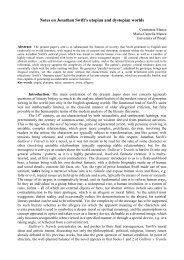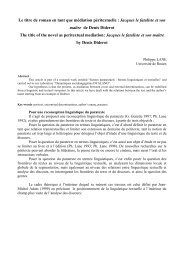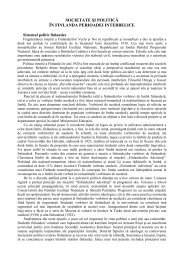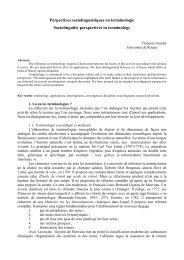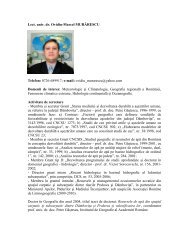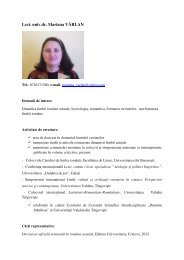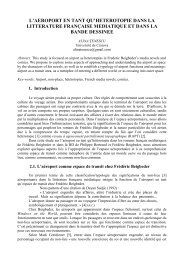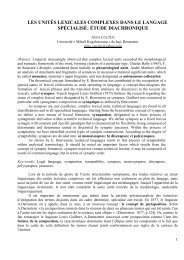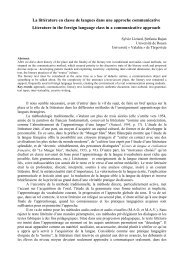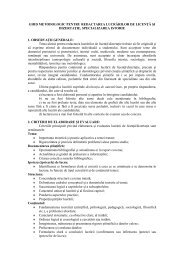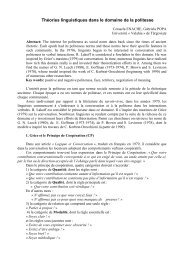THE ANNALS OF „VALAHIA” UNIVERSITY OF TÂRGOVIŞTE
THE ANNALS OF „VALAHIA” UNIVERSITY OF TÂRGOVIŞTE
THE ANNALS OF „VALAHIA” UNIVERSITY OF TÂRGOVIŞTE
Create successful ePaper yourself
Turn your PDF publications into a flip-book with our unique Google optimized e-Paper software.
30<br />
The Annals of „Valahia” University of Târgovişte<br />
4.3. Other contextual ways of analyzing the vocabulary of affectiveness<br />
The specialized literature dealing with abstract words from a morphosyntactic<br />
perspective proposes numerous contextual solutions, yet their importance<br />
for the identification of the meaning is low. We are thinking about the highlighting<br />
of combinations with certain verbs, specific either for the names of sentiments, or<br />
for the names of attitudes.<br />
The specialists consider that the names of sentiments are a very well<br />
delimited syntactic class (note 12). There are contexts allowing the differentiation<br />
of the “sentimentului” from „attitude”: a simŃi, a avea IUBIRE (to feel, to have<br />
love); a manifesta, a arăta IUBIRE (to manifest, to show love). The possible<br />
combinations of these names of sentiments with the verbs a arăta / manifesta (to<br />
show, to manifest) can be considered a form of exteriorization and implicitly of<br />
reification of these feelings. A “gliding of the sense” occurs, which makes it even<br />
more difficult to to draw the line between sentiments / attitudes / states.<br />
A more complex contextual way of studying the behavior of abstract words<br />
concerns their presence in evaluative phrases or in phrases of identification.<br />
Leaving aside certain syntactic goals, the objective pursued from a semantic<br />
viewpoint is the identification through context of a referent able to make the sense<br />
of the abstract words more tangible and, implicitly, accessible. Reification via the<br />
construction of a concrete referent is possible in such contexts as:<br />
IUBIREA şi hazardul sunt doi copii. (Love and hazard are two children.)<br />
Liniile curbe semnifică MELANCOLIE. (Curved lines signify melancholy)<br />
The analysis of several types of texts and contexts (note 13) shows that, in<br />
numerous situations, reification is disputable, the relation being established with<br />
yet another abstract word: IUBIREA este un ideal / un scop / o stare ... (Love is<br />
an ideal/ a purpose / a state…). At the same time, it results a very large, varied,<br />
heterogeneous array of combinations that do not favor stabile or categorical<br />
semantic distinctions (except for the recognition of a predictable sense of the<br />
affective term). This situation can be observed:<br />
• both in the case of evaluative phrases:<br />
IUBIREA adevărată / lumească / pământească / completă...<br />
(True/worldly/earthly/complete love)<br />
• and in the case of phrases of identification:<br />
IUBIREA este un ideal / un scop / o stare sufletească / o himeră... (Love is<br />
an ideal/ a purpose / a condition of the soul / a chimera)<br />
The contextually-built referent of both types of phrases can nevertheless<br />
contribute, in each case in turn, to the identification of some aspects of the meaning<br />
(or to the activation of certain semantic features).




